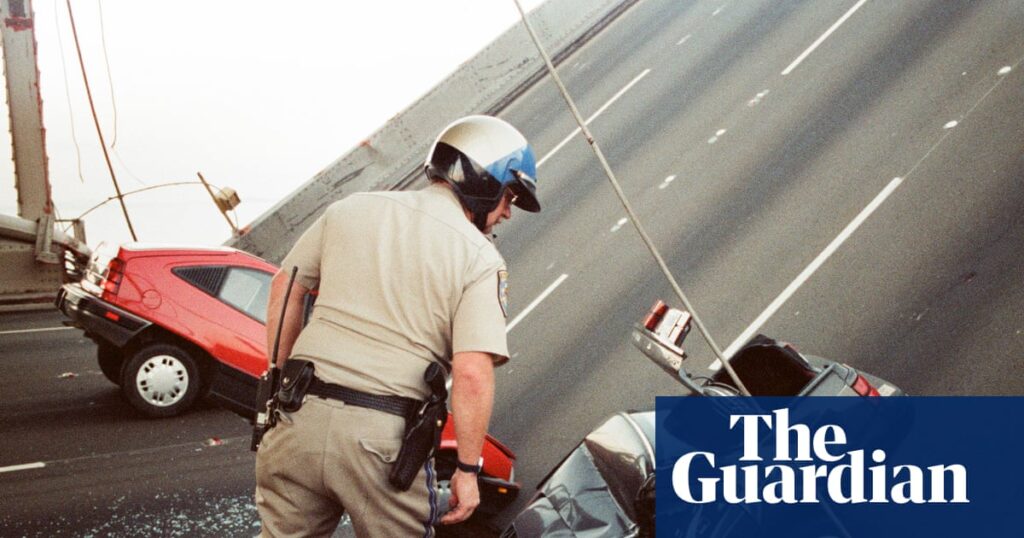Warnings about the looming threat of “the big one” – a catastrophic earthquake that could devastate cities – have stoked fears across the US west coast for decades. But according to a new study, a high-magnitude earthquake in the Pacific north-west could set off a secondary one on California’s San Andreas fault, causing an unrivaled catastrophe.
“The bigger one” would have the potential to wreak havoc up and down the coast at once, researchers say.
“We could expect that an earthquake on one of the faults alone would draw down the resources of the whole country to respond to it,” said lead author Dr Chris Goldfinger, a marine geologist and geophysicist. “If they both went off together, then you’ve got potentially San Francisco, Portland, Seattle and Vancouver all in an emergency situation in a compressed timeframe.”
The Cascadia subduction zone, which can produce magnitude 9 earthquakes on its own, has triggered temblors on the San Andreas fault in the past, according to the study, which was published on 29 September.
Goldfinger said the findings came after decades of head-scratching and a lot of data that was difficult to explain.
Drilling into deep-sea sediment cores that contain thousands of years of geologic history, the researchers combed through the layers left from ancient earthquakes. They thought the submarine landslide deposits were from San Andreas quakes “but they were upside down from what we typically see”, Goldfinger said.
“We realized that it wasn’t a single deposit,” he added, “it was two.”
The patterns, studied over decades through generations of graduate students led to a lightbulb moment around 2017 when the scientists realized they were evidence of synchronicity between the Cascadia subduction zone and the San Andreas fault.
By analyzing the sandy structures within turbidites, which are layers of sedimentary deposits, the scientists were able to determine some ruptures happened just hours – or sometimes even minutes – apart. There was evidence, according to the study, of 18 synchronized earthquakes during the last 3,000 years.
Their findings suggest that these back-to-back quakes are not the exception but rather occur in the majority of cases.
The most recent occurrence they uncovered was connected to a tremendous temblor in 1700, which sent a tsunami sweeping across the Pacific. Archeological artifacts show that homes of the Cowichan people living on Vancouver Island were leveled during the magnitude 9 earthquake, which also caused landslides and severe subsidence, all left behind in the geological record.
The researchers have now found that a second quake – up to a magnitude 7.9 – likely affected northern California shortly after the first struck.
Experts have long hypothesized that faults could be connected but this study offers the greatest amount of evidence of the significant dangers with the potential to affect millions of people.
A magnitude 9 earthquake along the Cascadia subduction zone fault has the potential to produce an initial tsunami wave of up to 80ft that would slam into coastal communities within 30 minutes after shaking begins, according to a scenario sketched out by federal emergency managers in 2022. Their analysis found the impact from the quake would stretch across more than 140,000 sq miles, affecting people in three states and parts of Canada, and the following tsunami would reach 27 countries and 17 tribes.
According to a similar kind of analysis that was done on a magnitude 7.8 earthquake on the southern San Andreas, areas of California could shake for more than two minutes, causing more than 1,800 deaths, 50,000 injuries and $200bn in damage, with “severe, long-lasting disruption”.
Large earthquakes on these faults occur roughly every 200 years, according to experts.
Together, these events would cause unprecedented destruction. But for Goldfinger, there is a silver lining: Cascadia going off, he said, could serve as a natural early warning system giving those who might be affected by a San Andreas quake more time to prepare.
The breakthrough in the science, even though it comes with terrifying implications, is also giving researchers more insights that will aid in adapting and responding when catastrophes occur.
“Our preparedness level is poor,” Goldfinger said. “We have a long way to go, and all these areas were built on top of ticking time bombs.”
The work also keeps the dangers fresh on the minds of emergency managers and residents in the places most at risk. While it’s uncertain when the next large earthquake might occur, there’s still time to prepare.
“Get earthquake insurance. Explore options for strengthening homes built to older standards,” Ben Deci, the senior media officer for the California Earthquake Authority, said in an emailed response. “Know what to do when the shaking starts: drop, cover and hold on.”
”Environmental risks are interconnected on so many levels,” he added. “Understanding that can be an important first step toward inspiring people to participate in an ecosystem of resilience.”

